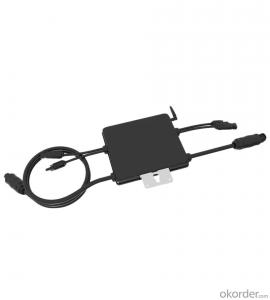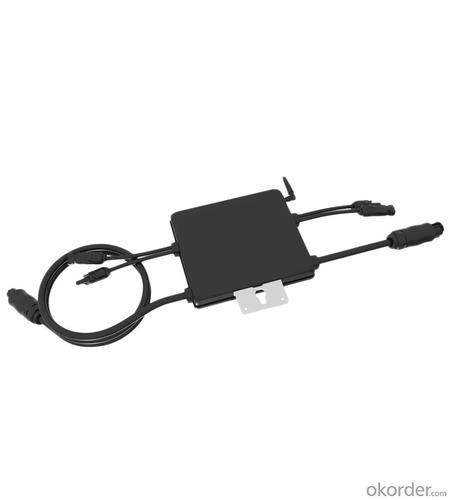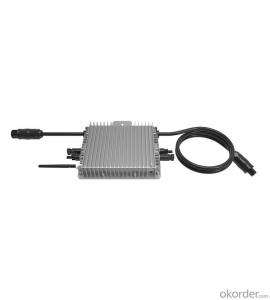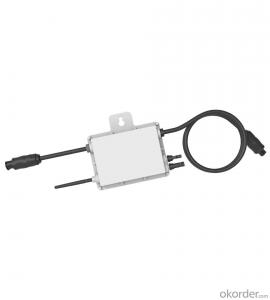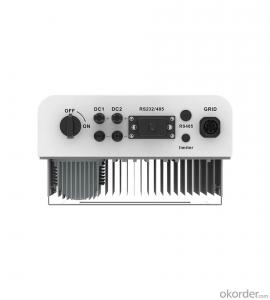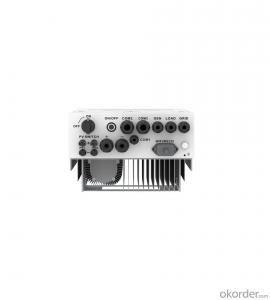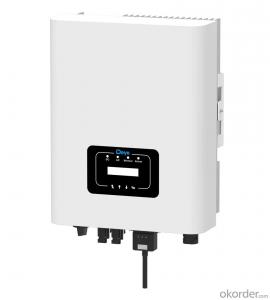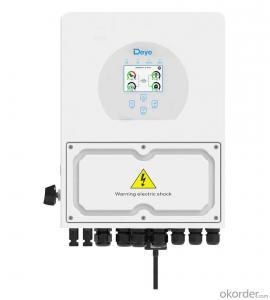Gan Solar Inverter Sun500g/600g | 500-600w | Single Phase | 2 MPPT | Micro-Inverter | Rapid Shutdown
- Loading Port:
- Ningbo
- Payment Terms:
- TT OR LC
- Min Order Qty:
- 100 pc
- Supply Capability:
- 5000 pc/month
OKorder Service Pledge
OKorder Financial Service
You Might Also Like
Specification
The series microinverter features low startup voltage of 20V and Max. DC input volage of 60V. Module-level monitoring providing each panel’s performance data, faster O&M. With built-in WIFI module, easier installation and commissioning for installer. Also, it supports various output voltage and frequency, 127/208/240V@60Hz, 230V/50Hz.
Rapid shutdown function
IP67 protection degree,10 years warranty
PLC, Zigbee or WIFI communication
2 MPP trackers, module level monitoring
Cooling glue filling, good thermal performance
Suitable for Europe, North America, South America and other regions
| Model | SUN500G-230-EU | SUN600G2-US-208/240 | SUN600G2-US-220 | SUN600G2-US-127 |
| Input Data (DC) | ||||
| Recommended input Power (STC) | 210~400W (2 Pieces) | 210~400W (2 Pieces) | 210~400W (2 Pieces) | 210~350W |
| Maximum input DC Voltage | 60V | |||
| MPPT Voltage Range | 25~55V | |||
| Operating DC Voltage Range | 20~60V | |||
| Max. DC Short Circuit Current | 13A | |||
| Max. input Current | 10.4A×2 | |||
| Output Data (AC) | ||||
| Rated output Power | 600W | 600W | 600W | 500W |
| Maximum output Power | 600W | 600W | 600W | 500W |
| Maximum output Current | 2.2A | 2.9A / 2.5A | 2.7A | 4A |
| Nominal Voltage / Range | 184~265V | 208V / 183~229V 240V / 211~264V | 220V/176~242V | a.c.95~155V @127Vac |
| Nominal Frequency / Range | 50.0 / 47.5~51.5Hz | 60.0 / 59.3~60.5Hz | 60.0 / 59.3~60.5Hz | 60.0 / 59.3~60.5Hz |
| Extended Frequency / Range | 50.0 / 45~55Hz | 60.0 / 55~65Hz | 60.0 / 55~65Hz | 60.0 / 55~65Hz |
| Power Factor | >0.99 | |||
| Maximum units per branch | 11 8 / 10 9 6 | |||
| Efficiency | ||||
| CEC Weighted Efficiency | 95% | |||
| Peak Inverter Efficiency | 96.5% | |||
| Static MPPT Efficiency | 99% | |||
| Night Time Power Consumption | 50mW | |||
| Mechanical Data | ||||
| Ambient Temperature Range | -40~65℃ | |||
| Size (mm) | 185W×161H×29D (Without mounting bracket and cable) | |||
| Weight (kg) | 2.4 | |||
| Cooling | Natural cooling | |||
| Enclosure Environmental Rating | IP67 | |||
| Features | ||||
| Compatibility | Compatible with 60~72 cell PV modules | |||
| Communication | Power line / WIFI / Zigbee | |||
| Compliance | UL1741、VDE0126、VDE4105、IEC62109、CE、INMETRO | |||
| Warranty | 10 years | |||
- Q: How does a solar inverter handle variations in battery charge levels?
- A solar inverter typically handles variations in battery charge levels by constantly monitoring the charge level of the battery. It adjusts the energy flow from the solar panels to the battery based on its charge level. When the battery charge is low, the inverter increases the energy flow from the solar panels to charge the battery. Conversely, when the battery charge is high, the inverter reduces the energy flow to prevent overcharging. This dynamic control ensures efficient use of the available solar energy and optimal charging of the battery.
- Q: Can a solar inverter be used in standalone power systems?
- Yes, a solar inverter can be used in standalone power systems. Standalone power systems, also known as off-grid systems, are not connected to the traditional electrical grid. In such systems, solar inverters convert the direct current (DC) generated by solar panels into alternating current (AC) that can be used to power various electrical devices and appliances. The solar inverter is an essential component in standalone power systems as it enables the efficient utilization of solar energy for off-grid applications.
- Q: What is the role of a reactive power controller in a solar inverter?
- The role of a reactive power controller in a solar inverter is to regulate and manage the reactive power flow in the electrical system. It ensures the power factor remains within acceptable limits, improving the overall stability and efficiency of the solar inverter system. The reactive power controller monitors the reactive power demand and supply, adjusting the voltage and current as needed to maintain a balanced power factor and minimize losses in the system.
- Q: How do you choose the right size solar inverter for your system?
- To choose the right size solar inverter for your system, you need to consider the total power output of your solar panels and the maximum power rating of the inverter. It is important to match the inverter's capacity with the maximum power output of your solar panels to ensure optimal performance and efficiency. Additionally, factors such as the type of system (off-grid or grid-tied) and future expansion plans should also be taken into account when determining the appropriate size of the solar inverter for your system.
- Q: What is the maximum number of solar panels that can be connected to a solar inverter?
- The maximum number of solar panels that can be connected to a solar inverter depends on various factors such as the power rating of the inverter, the voltage and current ratings of the solar panels, and the configuration of the solar array. It is typically recommended to consult the manufacturer's specifications or guidelines to determine the maximum number of panels that can be connected to a specific solar inverter.
- Q: What are the potential risks of over-discharging a battery connected to a solar inverter?
- The potential risks of over-discharging a battery connected to a solar inverter include reduced battery lifespan, decreased storage capacity, increased internal resistance, and potential damage to the battery cells. Over-discharging can lead to deep cycling, which can degrade the battery's performance and shorten its overall lifespan. It may also cause the battery to lose its ability to store energy efficiently, resulting in reduced storage capacity. Additionally, over-discharging can increase the internal resistance of the battery, leading to decreased efficiency and lower power output. In severe cases, over-discharging can cause irreversible damage to the battery cells, rendering them unusable and necessitating replacement.
- Q: Can a solar inverter be used with a monitoring system?
- Yes, a solar inverter can be used with a monitoring system. In fact, many solar inverters are equipped with built-in monitoring capabilities, allowing users to track the performance and output of their solar energy system in real-time. Additionally, there are also external monitoring systems available that can be integrated with a solar inverter to provide more advanced monitoring features and data analysis.
- Q: Can a solar inverter be used with a solar-powered pool heating system?
- Yes, a solar inverter can be used with a solar-powered pool heating system. The solar inverter is responsible for converting the direct current (DC) electricity generated by the solar panels into alternating current (AC) electricity that can be used to power the pool heating system. By connecting the solar inverter to the solar panels and the pool heating system, the solar energy can be efficiently harnessed and utilized to heat the pool.
- Q: What is the role of a solar inverter in a microgrid system?
- The role of a solar inverter in a microgrid system is to convert the direct current (DC) electricity generated by solar panels into alternating current (AC) electricity that can be used to power various appliances and devices within the microgrid. Additionally, the solar inverter helps manage the flow of electricity between the microgrid and the main utility grid, allowing for efficient energy distribution and grid stability.
- Q: How does a solar inverter affect the value of a property?
- A solar inverter can positively affect the value of a property by increasing its desirability and potential energy savings. It allows for the conversion of solar energy into usable electricity, reducing reliance on the grid and potentially lowering energy bills. Additionally, having a solar inverter in place can demonstrate a commitment to sustainability and environmental consciousness, which may be appealing to potential buyers and increase the property's overall value.
Send your message to us
Gan Solar Inverter Sun500g/600g | 500-600w | Single Phase | 2 MPPT | Micro-Inverter | Rapid Shutdown
- Loading Port:
- Ningbo
- Payment Terms:
- TT OR LC
- Min Order Qty:
- 100 pc
- Supply Capability:
- 5000 pc/month
OKorder Service Pledge
OKorder Financial Service
Similar products
Hot products
Hot Searches
Related keywords
